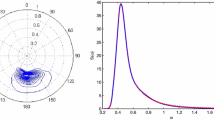Abstract
A numerical method is designed to examine the response properties of real sea areas to open ocean forcing. The application of this method to modeling the China’s adjacent seas shows that the Bohai Sea has a highest peak response frequency (PRF) of 1.52 d−1; the northern Yellow Sea has a PRF of 1.69 d−1; the Gyeonggi Bay has a high amplitude gain plateau in the frequency band roughly from 1.7 to 2.7 d−1; the Yellow Sea (including the Gyeonggi Bay), the East China Sea shelf and the Taiwan Strait have a common high amplitude gain band with frequencies around 1.76 to 1.78 d−1 and are shown to be a system that responds to the open ocean forcing in favor of amplifying the waves with frequencies in this band; the Beibu Gulf, the Gulf of Thailand and the South China Sea deep basin have PRFs of 0.91, 1.01 and 0.98 d−1 respectively. In addition, the East China Sea has a Poincare mode PRF of 3.91 d−1. The PRFs of the Bohai Sea, the northern Yellow Sea, the Beibu Gulf and the South China Sea can be explained by a classical quarter (half for the Bohai Sea) wavelength resonance theory. The results show that further investigations are needed for the response dynamics of the Yellow Sea-East China Sea-Taiwan Strait system, the East China Sea Poincare mode, the Taiwan Strait, and the Gulf of Thailand.
Similar content being viewed by others
References
An S A. 1977. A numerical experiment of the M2 tide in the Yellow Sea. J Oceanogr Soc Jap, 33(2): 103–110
Cao Deming, Fang Guohong. 1990. A numerical model of the tides and tidal currents in Beibu Bay. Oceanologia et Limnologia Sinica, 21(2): 105–113
Choi B H. 1980. A tidal model of the Yellow Sea and the Eastern China Sea. KORDI Report 80-02. Seoul: Korea Ocean Research and Development Institute
Defant A. 1961. Physical Oceanography, Vol. 2. Oxford: Pergamon Press, 598
Fang G H, Kwok Y-K, Yu K, et al. 1999. Numerical simulation of principal tidal constituents in the South China Sea, Gulf of Tonkin and Gulf of Thailand. Cont Shelf Res, 19(7): 845–869
Fang G H, Yang J, Thao Y. 1984. A two-dimensional numerical model for tidal motion in the Taiwan Strait. Mar Geophys Res, 7(1): 267–276
Garrett C. 1972. Tidal resonance in the Bay of Fundy and Gulf of Maine. Nature, 238(5365): 441–443
Garrett C. 1975. Tides in gulfs. Deep-Sea Res, 22: 23–35
Godin G. 1993. On tidal resonance. Cont Shelf Res, 13: 89–107
Heath R A. 1981. Estimates of the resonant period and Q in the semi-diurnal tidal band in the North Atlantic and Pacific Oceans. Deep-Sea Res, 28A(5): 481–493
LeBlond P H, Mysak L A. 1978. Waves in the Ocean. Netherland: Elsevier, 602
Lin M-C, Juang W-J, Tsay T-K. 2001. Anomalous amplifications of semidiurnal tides along the western coast of Taiwan. Ocean Engineering, 28(9): 1171–1198
Munk W H, Cartwright D E. 1966. Tidal spectroscopy and predication. Phil Trans Roy Soc London: Ser A, 259(1105): 533–581
Proudman J. 1953. Dynamical Oceanography. London: Methuen, 409
Sutherland G, Garrett C. 2005. Tidal resonance in Juan de Fuca Strait and the Strait of Georgia. J Phys Oceanogr, 35(7): 1279–1286
Roos P C, Velema J J, Hulscher S J M H, et al. 2011. An idealized model of tidal dynamics in the North Sea: resonance properties and response to large-scale changes. Ocean Dyn, 61(12): 2019–2035
Webb D J. 2013a. On the shelf resonances of the English Channel and Irish Sea. Ocean Sci, 9(4): 731–744
Webb D J. 2013b. On the tides and resonances of Hudson Bay and Hudson Strait. Ocean Sci, 10(6): 2053–2083
Yanagi T, Inoue K. 1994. Tide and tidal current in the Yellow/East China Sea. La Mer, 32: 153–165
Zu Tingting, Gan Jianping, Erofeeva S Y. 2008. Numerical study of the tide and tidal dynamics in the South China Sea. Deep-Sea Res, 55(2): 137–154
Author information
Authors and Affiliations
Corresponding author
Additional information
Foundation item: The National Natural Science Foundation of China under contract Nos 40676009 and 40606006; the Basic Research Project of Qingdao Science and Technology Program of China under contract No. 11-1-4-98-jch.
Rights and permissions
About this article
Cite this article
Cui, X., Fang, G., Teng, F. et al. Estimating peak response frequencies in a tidal band in the seas adjacent to China with a numerical model. Acta Oceanol. Sin. 34, 29–37 (2015). https://doi.org/10.1007/s13131-015-0593-z
Received:
Accepted:
Published:
Issue Date:
DOI: https://doi.org/10.1007/s13131-015-0593-z




